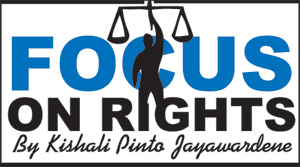Columns
Who is to blame for shaming Sri Lanka?
View(s):A chance conversation this week reminded me forcefully as to why and how Sri Lanka’s problems of reconciliation between communities and indeed, of post-war understanding between social classes remain so hopelessly tangled.
Excruciating angst of the middle class
This was when a matron domiciled overseas took umbrage at demonstrators holding placards against the government at international conferences, including the November 2013 Commonwealth Summit, querying plaintively as to whether this was not shameful to the image of the country. When asked for a precise clarification, her answer was ‘well, whatever happened during the war, are these not problems that should be sorted out within the country? Does not talking about this outside tarnish all Sri Lankans, making us objects to be laughed at by others?’

Taking these questions superficially, the sheer self-centeredness revealed thereby is veritably mind-boggling. So, it does not matter as to what atrocities were committed or continue to be committed post-war by a government, what matters only is that we are not ‘shamed’ internationally? And it is not the pain of Northern mothers and fathers asking ceaselessly as to what had happened to their disappeared children, (as much as the parents of Southern children asked equally anguished – and yet unanswered – questions decades ago), that is of concern but the excruciating angst of the middle class who writhe uncomfortably when visiting foreign heads of government are besieged by parents of the disappeared?
Moreover and crucially, is it not the government which has shamed this country through its manifold violations of Sri Lanka’s own law and the Constitution, including the unconscionable witch-hunting of a sitting Chief Justice some months ago? But this is not the issue. Rather, public demonstrations exposing subversions of governance are frowned upon by elites who whiz around in newly beautified Colombo and marvel in gaping wonder at mushrooming expressways built at magnificently corrupt economic cost.
Displaying scorn towards CHOGM
My reference to class at the outset of this column was deliberate. For it is important to understand that the question here is as much about class as it is about ethnicity. Let us examine the realities. In Sri Lanka, there is a politically and economically privileged Tamil class which is quite at ease regarding the trajectory of this administration’s policies since it vastly benefits thereof. These are not people who care a whit for their own people as much as the Sinhalese elite casually dismiss the ‘great unwashed’ as it were. It is not privileged Tamils after all who are on Jaffna’s streets asking for answers, post-2009.
And when the Southern insurrection was at its full horrific height in the late eighties, it was not the Southern upper middle class, (with the singular exception of the extra-judicial killing of Richard de Zoysa), which had to bear the brunt of the government’s counter-terror. Instead, these were the ‘ordinary’ Sinhalese as much as the ‘ordinary’ Tamils who now weep for justice. This is the enduring story of Sri Lanka. Indeed, even now and in these difficult times under an unbearably authoritarian Presidency, the most stinging critical commentary of government comes from the vernacular media which, for example, displayed its scorn towards the nonsense that was CHOGM is no uncertain terms.
Meanwhile let us not dwell beyond a moment on those parts of the Sinhalese and Tamil ‘diaspora’ whose shrill diatribes in either defending the Rajapaksa government or in crucifying it, is done most pleasurably from their Western domiciles or during whistle-top tours to Sri Lanka. This is not to say that the entire ‘diaspora’ should be painted with the same brush; indeed there are well informed and truly concerned people amongst them. Nonetheless, the voices that are heard are unfortunately otherwise inclined, as evidenced through this chance conversation that I had to my disconcerted surprise this week.
Exposing profound ignorance
At a deeper level, the extent of profound ignorance that emerges through such conversations is shocking. Did this questioner bother to ascertain for herself the fact that Northern parents had, in fact, moved nearly literally heaven and earth in the post-war years to find out what had happened to their loved ones? Mothers have despairingly shown me pictures of their disappeared children photographed behind bars at government detention centres by visiting foreign journalists. However, when they make the journey to Welikada and Boosa expending their meagre means, they are merely met with stony silence.
And are those who shudder at the sight of placard-holding demonstrators aware that President Mahinda Rajapaksa downwards to local members of parliament had been uselessly petitioned for answers? That the government’s own Lessons Learnt and Reconciliation Commission’s recommendations as to the urgent administrative resolving of this outstanding issue had been disregarded? That the government’s limited response two years thereafter to appease growing international pressure was to appoint yet another commission of inquiry that is ongoing? And given our dismal history, we may justifiably be pardoned for abstaining from ecstatic rejoicing as to its efficacy until this is practically proven.
Following an excellent precedent
But the best answer to this deplorably uninformed objection that Sri Lanka’s ‘dirty linen’ should not be washed internationally, comes from none other than President Mahinda Rajapaksa himself who, in an infinitely more preferable avatar as an opposition parliamentarian, once waxed strident against the Southern disappearances of the eighties in the corridors of the United Nations.
Famously he was stopped at the Katunayake International Airport on one such occasion and ‘incriminating’ material taken away from him. Indeed placard-holding demonstrators were a most useful tactic practised by parliamentarian Rajapaksa at that time to whip up national fury and successfully unseat the governing United National Party.
Sri Lankan demonstrators, protesting against the atrocities of his administration post 2009, are only following in this excellent lead. Should they be blamed for this? One thinks not, surely.

